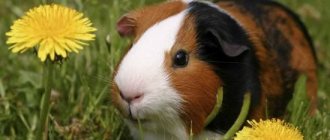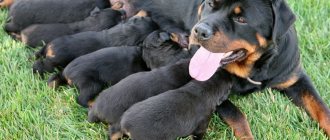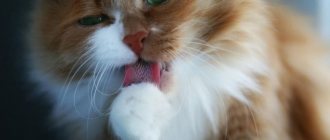What are the benefits of guinea pigs?
The first guinea pigs came to Europe thanks to the conquistador de Quesada; he discovered the funny rodent in America, where it was raised on “farms” for further consumption, because it has valuable and dietary meat. It would seem that eating such an animal is quite problematic, because it is small in size.
However, the Indians explained this by the fact that pigs reproduce much faster than, for example, rabbits, so keeping these animals is much more expedient. When you first hear the term “guinea pig,” you are surprised how the name can be so inconsistent with the rodent, but if you take a closer look and watch its habits, you will notice that the animal really behaves like a little pig. This is manifested in his habits and excessive curiosity.
Guinea pigs are funny and calm animals
The guinea pig is a quiet, calm and peaceful animal. They allow humans to pet them and play with them; they prefer nuts and plant seeds. It is important to monitor your pig’s diet, especially pay attention to nuts, because if you overdo it, a trip to the veterinarian cannot be avoided. The animal treats children well, even after they have stood near the cage for several hours hoping to play. Indeed, children adore this fluffy and kind pet.
Rodents live in a quiet room, although after a while they can adapt to a noisy room. The big advantage of the pig is that it makes virtually no sounds. Sometimes a pregnant female may "talk" to the male for several minutes during pregnancy. Although males also do not mind purring during the mating season, it is so quiet and short-lived that it is unlikely to irritate anyone.
If you treat the animal well and skillfully, then it will reward you with constant attention and a desire to sit in your arms. However, this attitude may change as the pig gives birth. In this case, she will begin to protect her children from everyone and everything that moves and breathes. This reaction can be explained by the fact that in the wild, females rarely give birth to offspring, since due to excessive sexual activity of males they miscarry.
She will behave this way for about a month, then the offspring can be transplanted to another place, which will make the mother’s temperament good again. Increased aggressiveness of a rodent can appear due to poor treatment, so when “playing” with an animal, one must not forget about their vindictiveness. If there are children at home, then you need to make sure that the boys’ pig does not become a test pilot, and the girls’ pig does not become a princess in a tight dress.
Common causes of death
Childbirth
Despite the fact that the guinea pig is considered the most prolific rodent, difficult situations associated with risk to life arise during pregnancy and after childbirth. Frequent occurrences are:
- Toxicosis. Occurs in the last week of pregnancy or in the first days of birth of the offspring. The reason is poor maintenance and care. It is impossible to help an animal with the development of toxicosis.
- The remaining placenta in the uterus.
- Complications during difficult childbirth. If there is obstruction of the birth canal or vaginal prolapse, immediate surgical intervention is required.
The death of offspring is observed if the female refuses to feed the babies.
Fight
Rumors about the superior fighting qualities of males in the same cage are exaggerated
Fighting for the female's attention, opponents can inflict injuries on each other, including deep lacerations. But there were no deaths
After anesthesia
During surgery, the dose of anesthesia for the rodent is carefully calculated. However, death can occur from advanced disease or due to pathology of the heart muscle.
Sudden death
Cases of unexpected death of a pet happen, like every living creature. The factors can be varied; an autopsy of the pet will help determine the cause.
How to tell if your guinea pig has a cold
The first signs of illness in a pet are severe lethargy and refusal to feed; a cold in a guinea pig is manifested by the following symptoms:
- a sick animal often sneezes and constantly rubs its nose, breathes heavily, coughs, and sometimes wheezing can be heard;
- the eyes become red and swollen, there is lacrimation, discharge from the nose and eyes;
- the sick animal lies or sits motionless;
- the coat looks dull and disheveled;
- there is an increase in body temperature.
A sick animal can be successfully cured of a cold only by promptly contacting a specialist.
Self-treatment is fraught with the development of complications and deterioration in the furry patient’s health. If a funny animal has a stuffy nose, it is urgent to clear the nasal cavity of mucus to facilitate breathing and prevent the infection from spreading into the bronchi and lungs.
It takes 2 people to rinse a guinea pig's nose. One secures the animal in a supine position. and the other performs a therapeutic procedure:
- Place one drop of warm chlorhexidine solution into each nostril.
- Wipe the nasal planum dry with a gauze swab.
- Place children's immunomodulating drops "Derinat" into your nose.
- Place the animal on its paws.
After the procedure, the furry rodent experiences a reflex sneezing, clearing the nasal cavity of mucus, pathogenic bacteria and viruses. Cleansing the nose should be done 3 times a day for 5 days.
Stages of guinea pig sneezing
When rhinitis is complicated by inflammation of the eyes, coughing and wheezing, a veterinarian uses symptomatic therapy: washing the eyes with boiled water with instillation of anti-inflammatory drops, giving the small patient expectorant decoctions of medicinal herbs, a glucose solution with vitamin C and Gamavit, a course of antibacterial or sulfonamide drugs.
Can he die from fright or melancholy?
The animal may completely refuse to eat and sleep, mourning its friend.
The guinea pig has a weak nervous system. The animal is quite timid and experiences stress from any incomprehensible incident.
A guinea pig can die from severe fright. Such facts are known. Rodent owners should take this information into account and treat the animal with care.
The animal is dependent on the company of other rodents and, if lost, is capable of yearning for it and even mourning it. Refusing food or avoiding contact indicates a feeling of grief. In order not to lose your pet, you should introduce a new friend, relieving loneliness.
Features of keeping guinea pigs
It is best for these rodents to purchase a cage of a lattice type so that the tray is made of plastic. Such a house will be well ventilated, and light will penetrate into it from any direction. The maximum distance between adjacent rods should be no more than 1.5 centimeters. The life expectancy of a pig is about 9 years on average, which is an excellent indicator for such a small mammal. For example, hamsters live about 5 times less.
Pigs of the same sex get along well together, fights and disagreements are extremely rare, and they are short-lived, after which the individuals quickly make peace. However, if you put two males and one female in one cage, then you should not expect peaceful cohabitation; moreover, this will cause a prolonged absence of offspring.
Guinea pigs usually get along well together
Plus, pigs have good immunity, which allows them to rarely get sick. However, their body may, for some reason, be weakened, which will cause some kind of illness. It is important to pay attention to any changes in your pet's behavior in order to recognize the symptoms of the disease in time, especially if your guinea pig is sneezing.
Allergy
Allergies can develop to things that are familiar to the pet, with which it had previously been in easy contact:
- litter for a tray or cage;
- feed, including hay and vegetables;
- dust;
- wool;
- the material from which toys are made.
Predisposition to allergies is inherited. When sick, the animal often sneezes, itching, rash, and watery eyes appear. The pet scratches its face until bloody wounds form.
To get rid of allergy symptoms, you should identify the allergen and replace it with a safe option. For example, switch to feed or sawdust from another company. If the reaction is caused by dust, the room will have to be wet cleaned more often. After getting rid of the source of the allergic reaction, the animal is given antihistamines.
https://youtube.com/watch?v=YldCu1gQM3E
Guinea pig snot
A runny nose in a pet rodent can be allergic in nature or be a symptom of a cold, as well as infectious rhinitis, bronchitis or pneumonia. Allergic rhinitis is manifested by liquid transparent discharge. Your furry pet may experience watery eyes, red eyes, skin rashes, and hair loss.
We invite you to read: Hypoallergenic cat food, tips for choosing
Most often, the cause of such a runny nose in guinea pigs is the furry animal’s reaction to an allergen. This could be new litter, low-quality or prohibited food, hay, indoor plants, chemicals, dust or pungent odors. Treatment consists of removing the allergen and using liquid antihistamines for children.
A guinea pig with a runny nose may develop a crust on its nose.
When a runny nose in a guinea pig is accompanied by lethargy and refusal to feed, you should immediately contact a specialist. Signs of a cold or infectious rhinitis may also include the following:
- the animal snorts through its nose;
- constantly fiddles with his muzzle;
- mucopurulent discharge from the nose and eyes.
It is necessary to treat a runny nose in a guinea pig at the first signs of illness; infectious rhinitis or a cold can quickly become complicated by pneumonia and can cause the death of your beloved animal.
Therapeutic measures for a runny nose in a domestic rodent begin with clearing the animal’s nasal cavity of mucus. The nose should be rinsed with a solution of chlorhexidine and drops of Derinat children's drops should be applied. For purulent nasal discharge, after rinsing, it is necessary to blow Streptocid powder into each nostril twice a day. It has an antimicrobial bacteriostatic effect.
Allergies in a guinea pig can manifest not only with a runny nose, but also with lacrimation.
If conjunctivitis is observed with rhinitis, it is necessary to rinse the eyes of the sick animal with boiled water twice a day, followed by instillation of anti-inflammatory drops. Often, with a runny nose, domestic rodents develop a cough, for the treatment of which it is necessary to give expectorant decoctions of anti-inflammatory herbs: breast milk, coltsfoot, nettle. If wheezing appears, the specialist prescribes a course of antibiotics or sulfonamides for the furry patient.
Associated symptoms (and their explanation)
The following accompanying symptoms (and their explanation) are extremely important. If they are interpreted correctly, they can save your pet's life or significantly speed up its recovery in the future.
Snot, nasal discharge
As a rule, snot and nasal discharge may indicate:
- Colds. In this case, the mucus is an inflammatory exudate.
- Allergies. In this case, it is rather not snot that is released from the nose, but a liquid, transparent exudate. This also indicates the onset of the inflammatory process.
- Snot may be a response to large amounts of dust entering the respiratory tract. The body tries to flush out excess from the upper respiratory tract.
- Presence of a foreign body. As in the previous case, the body tries to create conditions for the natural removal of waste.
Sneezing without snot from the nose
If the animal just has sneezing, without snot from the nose, then this may be a sign of:
- The presence of a large amount of dust in the air, when its particles irritate the mucous membranes of the respiratory tract.
- This happens when allergies or a cold begin, but soon snot (as a result of inflammation) will still appear.
- It is possible that something got into the pig’s nose, but this “something” has already safely flew out when sneezing.
The pig is constantly itching
If your pig is constantly itching and sneezing, then it is almost certainly an allergy. In some cases, this is how food intolerance manifests itself.
At the same time, a lot of histamine is released into the blood, causing severe itching.
Eyes become watery or festering
When your pig's eyes are watery or purulent, and she is sneezing, it is better to immediately take your pet to the veterinarian. This is how many dangerous viral diseases manifest themselves, which simultaneously affect the organs of the upper respiratory tract and the mucous membranes of the eyes.
Sneezing with bloody discharge
If your pig is sneezing with blood, this may indicate:
- The presence in the respiratory tract of a foreign body with uneven edges that has already damaged the delicate mucous membrane of organs.
- Inflammatory process. In this case, bleeding ulcers and wounds may appear on the surface of the mucous membranes.
The pig is wheezing or wheezing
If your pig sniffles or wheezes, and also sneezes, then this is almost certainly a sign of a serious cold. In addition, this may indicate a large foreign body blocking most of the respiratory lumen. In any case, if such symptoms are detected, it is better to immediately call a veterinarian.
The pig is lethargic and sneezing
When a pig is lethargic and sneezes uncontrollably, then we can say with almost complete certainty that the animal simply has a cold. Most likely, lethargy is explained by an increase in overall body temperature. Normally, in “pigs” it can fluctuate between 37-39°C.
What to do if your guinea pig has bronchitis
The cause of bronchitis in a pet can be a complication of a cold or infectious rhinitis, keeping a funny animal in a dusty or smoky room, hypothermia, pathogenic microorganisms or parasites.
If your guinea pig has bronchitis, it will cough a lot
The main symptom of bronchitis is a severe dry debilitating cough, the sick pet breathes heavily, refuses water and food, and there is purulent discharge from the nose and eyes. If left untreated, the furry animal dies from exhaustion or a heart attack.
To treat bronchitis, antimicrobial drugs, vitamins, immunomodulators, expectorants, hormonal and anti-inflammatory drugs are used.
Not everyone knows what to do if their little pet sneezes, let's look at this issue in more detail. It is not difficult to monitor the health of guinea pigs; they have very good protection against diseases. However, if you have already got such a rodent, then you need to know about diseases that may still appear.
If your guinea pig sneezes, you need to carefully monitor its behavior and record any changes. The fact is that this symptom may indicate the development of a dangerous disease, which may even threaten the life of the animal. If sneezing is one-time and not regular, then there is no reason to worry, because, like in humans, this can be a normal manifestation of life.
If a disease is detected, it is best to contact a veterinarian
The process of sneezing can occur regularly, then it makes sense to think about the presence of some pathology, in which case the little “patient” should be sent to the veterinarian. In a special institution, a specialist will examine and, if necessary, diagnose the animal; based on the data obtained, a diagnosis will be made. Next, the attending physician will draw up a detailed treatment plan, which will include taking medications and adjusting the diet.
Most often, diseases arise from viral infections. The most common are pseudotuberculosis, pestilence, and paralysis. When sick, rodents experience convulsions, their legs are lost, their fur becomes slimy, and the animal loses energy. At the same time, the rodent behaves nervously and its temperature rises. In such a situation, you need to immediately show the animal to a veterinarian.
It is best to isolate the animal from other pigs, if any. Also, the patient should not be allowed to come into contact with other pets, as well as children. In general, diseases are not transmitted to people, but for children, the appearance of their friend can significantly affect their psycho-emotional state.
Diseases can be caused by microorganisms - ticks, fleas. The rodent begins to get scabies and hair falls out in places. If the disease is not treated for a long time, the animal may develop ulcers. Fleas and ticks can be removed yourself, following the rules of care for a sick animal. Special products for destroying harmful microorganisms can be purchased at pet stores.
Your pet may eat worse and be lethargic
Internal parasites are also pathogens. Various types of worms can live in the body of a guinea pig. It is very difficult to determine that an animal is sick. The pet may eat less food, and its general condition worsens. In this case, it is better not to resort to treatment, but to bring the rodent to a veterinary clinic.
We suggest you read: Why does a cat bleed after giving birth? Bleeding in a cat after giving birth - when should you worry and when not? Helping a cat after birth
Digestive tract diseases can occur due to poor nutrition. The animal should not be fed with food intended for cats or dogs; buy food that is 100% suitable for guinea pigs. The animal develops diarrhea, its general condition becomes worse, and its appetite worsens. The animal should be shown to the doctor.
When hypothermia occurs, your guinea pig may develop a runny nose or pneumonia. This condition is very dangerous for the pig: its temperature rises, loss of strength, interest in eating food decreases, a runny nose, and heavy breathing. The sick animal constantly lies down and does not pay attention to stimuli. The animal needs to be shown to a doctor urgently.
Hypothermia may cause your pet to get sick.
Often, owners themselves create a menu for a little pig, thinking that popular foods contain all the necessary microelements and vitamins. Not every food contains an equal amount of nutrients, the lack of which can lead to vitamin deficiency in a guinea pig. These animals need to be enriched with vitamins A, C, D, E.
Guinea pigs cannot produce the amount of vitamin C they need. Without ascorbic acid in their diet, they may develop scurvy, the body's defenses will be reduced, and they will be more susceptible to viral diseases. If there is a lack of vitamin D, the animal's bones may become bent and growth may slow down.
Guinea pigs rarely get sick, but they tolerate the disease very difficult, so it is important not only to properly treat the disease, but also to prevent the development of pathology. To do this, you need to follow some rules, let's look at them in more detail:
- The feed should be based on hay, it should be present near the pig at all times, and also make sure that the feeder does not run out of grains, for example, wheat and oats.
- Dry food is exclusively an additive and not the main food, so no more than 1 tbsp is needed per pig. spoons.
- Vegetables and fruits are a delicacy; it is advisable to give them to the animal daily, but in small quantities. It is imperative to give cabbage, since it contains important vitamins and essential elements; they are not produced in the body on its own.
- The pig must always have access to clean water. You can often see in various articles that some pet owners add vitamin C to it, which is not necessary. The rodent drinks not often, but in large quantities, so it consumes about 300 ml per day. liquids. The water should be changed every day so that the animal does not experience problems with the digestive system.
- Mineral salt stones must be present in the guinea pig's cage. They can be purchased at a pet store and should be placed at eye level, right next to the watering hole.
- Nuts must be included in the pig’s diet, but their quantity should be strictly limited, since overeating is fraught with consequences, and this is especially unsafe with peanuts.
There are foods that the animal is prohibited from eating in any case. These include various cereals, meat, fermented milk foods, and boiled vegetables. Otherwise, your pig will get an upset stomach.
Pay attention to the bedding, it needs to be changed every 5 days. It should consist of sawdust or shavings with a fine fraction so that the pig can chew it. Many are afraid when she eats her own droppings, this is due to the fact that the body can absorb some vitamins only on the second visit.
Surprisingly, nature created it this way and you can’t do anything against it except come to terms with it, especially since it’s good for the health of the animal. By the way, after using antibiotics, it is necessary to restore the intestinal microflora; this can be done by drinking it with a solution from your own droppings.
The pig's cage should not be so high that it cannot climb high, since falling even from a small height can lead to dire consequences, such as death. In any case, the cage should have a small house for the pig so that it can feel safe and private there.
At first she will spend many hours there, but then she will gradually go to the feeder. Rodents are particularly unpretentious, so both a small house and a multi-storey cottage will suit them. The main thing is to have as much sunny time as possible. It wouldn’t hurt to put a running wheel in the cage, although these animals look slow and lazy, they still love to move.
A guinea pig is an ideal choice for those who want to have a cute, kind and loyal pet for a long time. These are very cunning and smart rodents, which, when trained, will be able to carry out some commands, for example, respond to their nickname. For small children, such a pet will be a real discovery, but it is advisable that they are over 6 years old, since kids can harm the pig, and for preschoolers it will become a real friend.
We suggest you read: Pet health: why a cat eats poorly and loses weight
How to cope with the loss of a pet?
A caring owner who devotes significant time to his pet can always identify signs of approaching death by noting a change in habitual behavior:
- Lack of appetite. A healthy pig will never refuse a treat or new food in the diet.
- Decreased activity. A pet in good health always shows curiosity and conducts exploratory forays with interest. In a young pig, fatigue and slow movements mean excess weight gain and possible obesity, as well as natural laziness.
- Labored breathing.
- Uncontrolled release of feces.
- Slow reflex movements and lack of response to stimuli.
Old age of the pet
An elderly pet looks sick and weak
- Cloudy eyes and cataract formation.
- Arthritis. The appearance of internal thickenings on the joints of the fingers.
- The presence of tumors under the fur.
- Difficulty moving the paws due to stiff joints.
Alas, old age cannot be delayed. You can only try to prolong the animal’s life with caring care, a diet enhanced with vitamins and leisurely walks.
Regular visits to a specialist will help identify the early stages of possible diseases. After all, even a common cold causes serious complications on the functioning of the heart and internal organs and can lead to death.
In addition to senile decline, the death of a guinea pig occurs for a number of reasons:
- Birth defects or genetic predisposition.
- Digestive diseases associated with improper feeding.
- Viral and infectious infections.
- Parasitic diseases.
- Mechanical damage to organs from falls or injuries.
Sadness for a departed pet is natural. The years spent together are priceless. Tears will help you get out of shock. Remembering your pet's antics, talking about his antics and sharing your feelings with loved ones can help you cope with the loss more easily.
Of course, the departure of a pet is a heavy loss not only for the other inhabitants of the cage, but above all for the pet’s owner. To prevent premature loss, you should take care of the animal throughout its life, pamper and love it.
Why does my guinea pig cough?
A cough in a domestic rodent is a protective reflex of the animal’s body, aimed at clearing the respiratory tract of irritants; in guinea pigs, cough is a symptom of the following pathologies:
- entry of a foreign body into the upper respiratory tract;
- cold;
- bronchitis;
- pulmonary edema;
- dental pathologies;
- pneumonia;
- parasitic diseases;
- heart failure.
Any type of cough in a small pet should not go unnoticed by the owner. If your beloved rodent is sneezing, coughing and wheezing, you should urgently seek the help of a specialist.
If your beloved pet coughs, wheezes, squeaks when eating, often chokes on food, picks at food, there is a decrease in appetite, weight loss and excessive drooling, you need to contact a specialist to examine the oral cavity of your pet rodent. This clinical picture is due to pathological regrowth of the anterior and cheek teeth.
Dental diseases of guinea pigs are treated only in a veterinary clinic using anesthesia; after a comprehensive examination of the furry rodent, the veterinarian grinds down and polishes the overgrown teeth.
Euthanasia
Unfortunately, due to old age, acute viral infection or severe mechanical injury, the pet’s life slowly fades away, and the suffering becomes unbearable to watch.
Euthanasia of a pig will be humane if the pet is suffering
No matter how painful it may be, euthanasia of a pet relieves it of pain.
At the beginning of the euthanasia procedure, the animal is given a strong anesthesia, after which the animal falls asleep. A subsequent medication, administered minutes later, stops the heart.
A doctor’s visit to your home or a visit to the clinic with your pet is the owner’s decision. A life-saving injection from pain and suffering costs from 1000 rubles.
Pneumonia in a guinea pig
Pneumonia in a guinea pig can be infectious or a complication of a cold, rhinitis, bronchitis or pulmonary edema. Most often, pneumonia is observed in weakened animals and young animals in the spring and autumn. Pneumonia can be caused by keeping furry pets in a draft, in a damp or cold room, changes in temperature and humidity, and improper transportation.
With pneumonia, the guinea pig is lethargic
Acute and chronic pneumonia occurs in guinea pigs. The acute form is dangerous due to its rapid current. The pet has a high fever, intoxication and exhaustion. He may die within 3-4 days from the onset of the disease. In advanced cases, treatment is not always effective. The chronic form does not have a clearly defined picture.
The development of pneumonia in a guinea pig is indicated by the following characteristic symptoms:
- refusal of food and water;
- dry or wet cough, depending on the form and stage of the disease;
- heavy, hoarse breathing with whistling and gurgling, the animal experiences shortness of breath, and when inhaling, the sides characteristically rise;
- inactivity, lethargy, a depressed animal sits, ruffled, in one place or lies, does not respond to treats or the owner’s voice;
- the small animal sneezes, grunts, sniffles, viscous purulent discharge is observed from the nose and eyes;
- the nose is covered with dried crusts of pus, the eyes are red, swollen, the palpebral fissure sticks together and purulent contents accumulate in the corners of the eyes;
- the coat is dull, tousled, stuck together;
- The guinea pig sleeps often and for a long time.
It is necessary to treat your pet at the first signs of illness under the supervision of an experienced specialist. An insidious pathology may have hidden symptoms. Often there is a significant improvement, followed by a relapse, deterioration of the condition and death of the beloved animal.
Treatment
If your guinea pig wheezes, your veterinarian will prescribe a course of antibacterial or sulfonamide medications. These include: “Baytril”, “Sulfazin”, “Sulfadimezin”. Medicines are used in a course only after determining the animal’s body’s response to the drug. Simultaneously with antibacterial therapy, it is necessary to give the patient probiotics: “Linex”, “Vetom”, “Bifidumbacterin”.
Every day it is necessary to clean the animal's nose by cleaning the muzzle from crusts of pus and rinsing with a chlorhexidine solution. After drying the nasal planum, it is recommended to blow Streptocid powder into each nostril twice a day.
In case of eye inflammation, it is necessary to wash the animal’s eyes twice a day with sterile saline solution, followed by instillation of anti-inflammatory drops “Tsiprovet”, “Tsipromed”.
To eliminate a cough, you need to give your pet expectorant mixtures of anti-inflammatory herbs or give the animal a drop of Bromhexine baby syrup.
After treatment, a guinea pig needs rehabilitation and good care.
To restore immunity and increase the body's resistance to colds, the pet is prescribed an increased dose of ascorbic acid with glucose, gamavit and echinacea tincture.
An increased amount of green grass, vegetables and fruits should be introduced into the diet of a sick pet. In case of complete refusal of food, the animal must be fed paste-like food from an insulin syringe without a needle. Small portions should be given 5-6 times a day.
Prevention of colds
Thus, timely prevention of colds can eliminate many problems:
- The cage is never placed near windows, doors (especially entrance doors that separate the house from the street), radiators, cold/hot water supply risers, etc. In all these cases, temperature changes will always occur in the pet’s home.
- Experienced “pig breeders” believe that the optimal temperature in a room with a cage is from 19°C to 23°C.
- There should always be sufficient bedding in the cage and be dry.
The last point is perhaps the most important. But maintaining dryness in the case of pigs can be difficult. To keep the litter dry as long as possible, it is made of three layers:
- Wood pellets of cat litter are used as the first layer.
- The second layer is sawdust from deciduous (very desirable) wood.
- Hay or high-quality straw is placed on top.
It is advisable to change the areas under the drinking bowl and latrine either daily or every other day. Complete replacement of litter - once a week.
Cold
This pathological condition is not a disease as such, but rather will be a response to hypothermia. The disease manifests itself not only by sneezing, but also by:
- a slight increase in body temperature (the norm for pigs is 37.5-39.5 ° C),
- poor appetite
- worsening mood;
- ruffled coat;
- redness of the eyes, watery eyes;
- heavy or rapid breathing;
- the nose is clogged with thick contents, which is why the pig “grunts” or “sniffles”; in some cases, thick green or brownish mucus is released from the nasal openings.
If you don’t assess your pet’s health in time and leave everything to chance, then in most cases a cold will turn into bronchitis or, even worse, pneumonia. Therefore, at the first symptoms or suspicion of hypothermia, the mumps must be treated.
Therapy
First of all, it is necessary to clear the nasal passages of contents.
To do this, the nose is washed with saline or chlorcesidine (literally a drop in each passage). After that, the nasal mirror is wiped with a napkin and then derinat is instilled. Usually after it the animal sneezes heavily, which is the norm. It is better to bury it together: one holds the piglet by the body, and the second person tilts the pet’s head back and carefully, using a syringe without a needle, injects the medicine into each nostril (one drop into each).
To boost immunity, ascorbic acid is added to the water; by the way, it should generally be present in the animal’s diet every day. During illness, the dose is 1.5-2 ml of a 5% vitamin C solution per adult pig once a day.
Echinacea tincture (up to 5 drops per head), gamavit (1 ml in water) also contributes to rapid recovery - both of these drugs are considered immunomodulators.
Instead of water, you can give chamomile infusions, breast milk and other anti-inflammatory herbs.
If there is wheezing in the chest, antibacterial drugs are prescribed. For these purposes, children's cold medicines, for example, Biseptol, are again suitable. You can buy Baytril (sold at a veterinary pharmacy). You need to be careful when prescribing antibiotics, as some are deadly to guinea pigs. Therefore, it is better to leave the choice of drug to your veterinarian.
Any antibiotic causes dysbacteriosis, to avoid it, bifidobacteria must be given.
It is recommended to use children's bromhexine as an expectorant (1 drop per day by mouth).
You should not self-medicate and if you suspect a serious illness, or even better, in any case, your pet is feeling unwell, seek help from a qualified specialist who can make a diagnosis and prescribe adequate treatment.
Prevention
To prevent colds, it is important to follow the rules and regulations:
firstly, drafts are avoided: the cage is installed away from windows, entrance doors, in a warm and dry room; secondly, the temperature in the room should not be lower than 18 °C; thirdly, pay attention to the litter: it should not be wet, rotten or damp.
Experienced breeders recommend setting up the bottom of the cage where guinea pigs are kept like a three-tier sandwich:
- A thin layer of filler - medium fraction granules;
- Wood sawdust;
- Thick layer of hay.
As often as possible, check the corners where babies most often defecate, and the place under the feeder and drinking bowl. If moisture is observed there, it is better to replace the litter with a new one. In any case, the shift is carried out at least once a week.
You should not walk with your pet in the cold season, and if due to circumstances you have to travel, then the animal is provided with the most comfortable and warm conditions.
Sneezing is a sign that forces you to pay close attention to the health of your guinea pig. You should never treat this symptom negligently and you definitely need to find out its cause, and then begin treatment
https://nalugah.ru/zhivotnovodstvo/morskie-svinki/pochemu-morskaya-svinka-chihaet-lechenie-prostudy-u-svinok.htmlhttps://msvinkam.ru/bolezni/morskaya-svinka-chihaet.htmlhttps:// yarus-spb.ru/gryzuny/morskaya-svinka/chihaet.html











